Get rid of your lawn eyesores with these tips.
18 Lawn Mysteries Explained (And How to Fix Them)
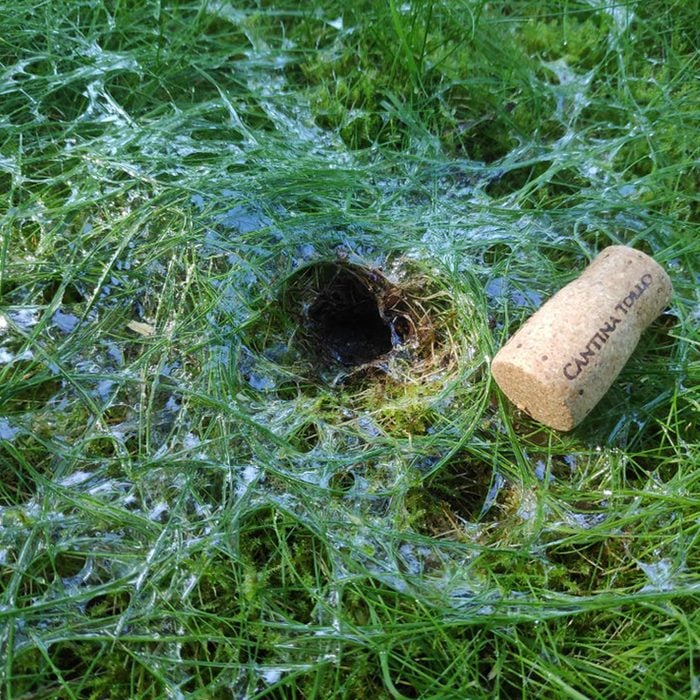
Why are There Holes in My Yard?
This Reddit user spotted unusual holes in their yard. The holes, surrounded by an apparent slime, are likely caused by slugs, as several of the commenters noted in the thread.
“Slugs prefer to burrow into the soil, up to six feet deep, for the cool and moist environment,” according to Oregon State University’s Master Gardener Association. “Only 5% of slugs are above ground at any one time. Snails seal themselves off with a parchment-like membrane for protection during hot, dry periods or when it is cold. During cold weather, snails and slugs hibernate in the topsoil. In areas with mild winters, snails and slugs can be active throughout the year.”
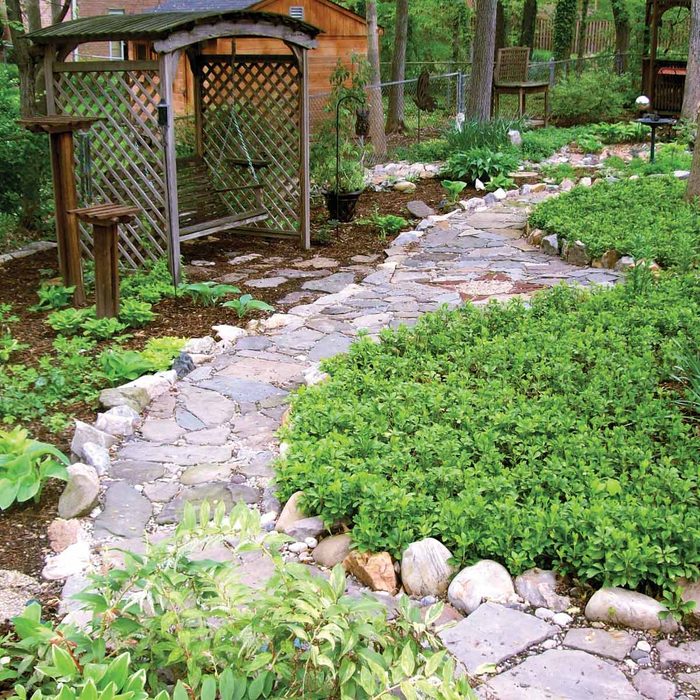
Why Won’t Grass Grow in Shaded Spots?
Problem: “My wife wanted grass, so I tried to grow it many times over the years. But thanks to the heavy shade cast by our oak trees, by mid-summer our backyard consisted of small, lonely tufts of grass surrounded by bare earth.”
Reader Solution: “My solution was to till most of the backyard (when my wife was gone for the day) and create a shade garden. Now that poor, sad grass is just a dim memory, and so far, the garden looks great.” Bob Rogers
Expert Input
A shade garden can be a beautiful way to deal with mature trees. However, planting a garden at the base of a tree can be challenging for both the plants and the tree. Shade isn’t the only issue: “The plants will also need to cope with dry soil and root competition,” says Doris Taylor, a plant information specialist at the Morton Arboretum near Chicago. “And many trees are sensitive to having their roots disturbed.” Taylor offers these suggestions for planting a successful shade garden without harming trees:
- Consult online resources and the local extension service to choose drought- and shade-tolerant plants for your zone.
- Newly established plants of any kind (even drought-tolerant plants) need supplemental water the first year. If the tree hates having its feet (roots) consistently wet, spot-water your new plants.
- Most tree roots are in the top 12 to 18 in. of soil and extend past the canopy. Don’t cover existing tree roots with more than 1 in. of soil or they can suffocate. Tilling near a tree can destroy the fine root hairs that take up water. Instead, plant in the pockets of soil between larger roots and add slow-release organic compost to the individual planting holes. Here’s how to easily identify different trees.
- Don’t plant closer than 12 in. from the trunk, and plant shallow-rooted perennials that don’t require frequent division such as hostas, liriope and sedum.
- Shallow-rooted species like oaks, lindens, magnolias and many maples are sensitive to disturbance and can be easily damaged. Consider adding a bench or planters instead of a shade garden. Plus, try one of these color plants that grow well in a shade garden.
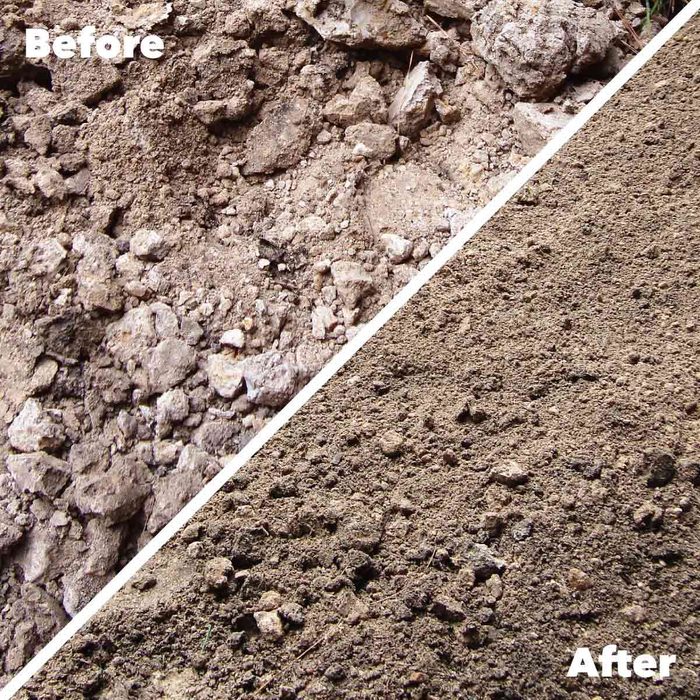
“Gumbo” Soil Won’t Drain
Problem: “Our clay soil is mush when wet and like concrete when dry, and nothing will grow in it.”
Reader Solution: “We’re in the process of amending our soil with expanded shale. It’s a gravel-size rock that’s pumped full of air. It aerates heavy clay soil, which makes it easier to work and helps it drain better. I’ve already noticed that the part of the garden we’ve done drained much better than the rest of the garden during the last rain.” Sue Blackburn
Expert Input
Sue has definitely done her research. According to Steve George, a horticulturist at the Texas Cooperative Extension service, your clay soil can benefit from expanded shale if it’s heavy and sticky when wet “and gets deep cracks when it’s dry in the summer.” Plants don’t grow well in clay soil because they don’t get enough oxygen. Expanded shale creates cavities in the soil to hold both air and water. George recommends adding 3 in. of 1/4-in. to 3/8-in. shale, along with 3 in. of compost and tilling them into your soil 6 to 8 in. deep. Then cover your garden bed with a 3-in. layer of mulch. Plus: These are our favorite landscaping tips for all house styles.
The good news about expanded shale is that unlike other amendments such as compost or fertilizer, you only need to add the shale to your garden beds once. After that, you’ll never need to add compost or commercial fertilizer again. The bad news is that expanded shale costs more than compost (about $10 for a 40-lb. bag; slightly less if you buy it in bulk). But according to George, it’s worth it. “Using expanded shale is just so much better. It makes it fun to garden in clay.”
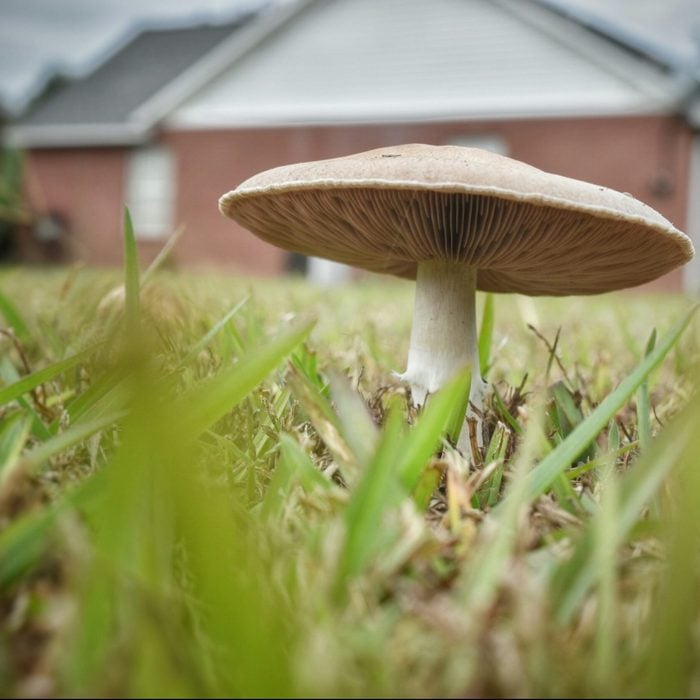
Why are There Mushrooms in My Yard?
Problem: “We have so many mushrooms in our lawn that they make the weeds seem easy to control. We must have six different kinds, and they’re worst after it rains. We’ve got a dog and grandkids, and those mushrooms are not only disgusting, but I’m worried someone’s going to eat one.”
Reader Solution: Elusive. “We’ve tried using fungicides, but they’re expensive, they require twice-weekly applications and you need to treat every single mushroom. If you miss even one application, the mushrooms come back and you need to start over again. We’re not sure what to do.” Eric Lucas
Expert Input: How to Get Rid of Mushrooms in the Yard
We have good news and bad news for you, Eric. The good news, according to University of Minnesota turf expert Bob Mugaas, is that while mushrooms can look unsightly (and they’re worse in years with a lot of rain), they’re actually beneficial to your lawn. “They’re part of the breakdown of organic material in the soil, and they help recycle nutrients.”
The bad news, as you’ve already discovered, is that mushrooms are nearly impossible to get rid of. They’re actually the fruit of an extensive underground root system. So even if you remove the visible mushrooms or use fungicides, the source of them is still there (they’re like the tip of an iceberg).
According to Mugaas, you have several options. “You can certainly pull them.” This won’t permanently rid your lawn of mushrooms, but it can give you temporary relief. There’s another name for mushrooms: white fungus balls in soil.
You can also make your lawn less hospitable to fungi by correcting drainage problems and eliminating decaying organic matter. Grind down stumps, rake up grass clippings, dig up buried lumber, aerate, dethatch and replace old mulch.
The easiest option (or maybe the hardest for you, Eric) is to make peace with your mushrooms. Their numbers will increase and decrease depending on the season. Teach your grandchildren never to eat mushrooms from the lawn, and during cool, wet periods, keep a close eye on your pets.

Seasonal Swamp
Problem: “I have a low spot in my yard that fills with runoff from our downspouts during rainstorms. It’s not a constant problem, but it’s a bear to grow grass there.”
Reader Solution: None yet. Help! Alena Gust
Expert Input
Alena, if you have workable soil (not clay), a rain garden is an easy and effective solution for a short-term, isolated drainage problem. “Building a rain garden means you don’t have to fight a losing battle to grow turf,” says Douglas Owens-Pike, plant ecologist and owner of EnergyScapes, a Minneapolis landscape design firm. “It’s also a great way to treat rainfall as a resource rather than a problem.”
All you need is a shallow depression (which it sounds like you already have) that has the soil amended so it drains quickly. Make sure your rain garden is located at least 10 ft. from your foundation so you won’t have any seepage problems in your basement. Plant it with shrubs and perennials that tolerate pooling water as well as periods of drought (type “rain garden” into your online browser and you’ll find tons of plant lists). The amended soil and water-loving plants capture the excess water, and it slowly percolates into the earth instead of running into the storm sewer or sitting on the surface of your lawn.
And according to Owens-Pike, rain gardens aren’t limited to flowers or areas with full sun. “Partially shaded areas planted with lower-growing trees and shrubs can create wonderful wildlife habitat rain gardens that become perfect nesting areas for birds.” (For detailed instructions for building a rain garden, type “rain garden.” in the search box above.) Next, check out 14 small-space landscaping ideas you can DIY.
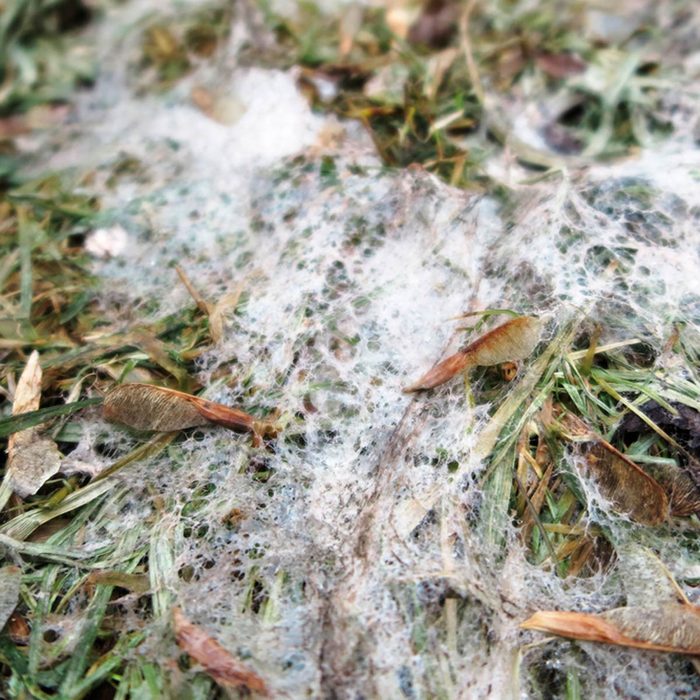
Snow Mold
You’ve heard the old saying, April showers bring May flowers, right? Well, they also bring snow mold! As the snow melts away every spring, your lovely lawn is vulnerable to an unsightly fungus. This is especially common if you live in an area that gets heavy snowfall and your lawn is a cool-season grass, such as Kentucky bluegrass, perennial ryegrass, fine fescue or tall fescue. Learning everything you need to know about snow mold will help you spot and address it this spring, or at the very least, prevent it next year.
Want a perfect lawn? Then follow these top 10 tips.
So, What is Snow Mold?
Put simply, snow mold is a fungal lawn disease that occurs in the spring after the snow melts. It comes in two forms: pink fungus (potentially more damaging), and gray fungus.
It most commonly occurs if the first large snow falls on ground that hasn’t yet frozen. This creates a perfect kind of blanket between grass and snow for fungus to grow from the spores that lay rather dormant throughout the rest of the season. This can be especially damaging if that area between snow and ground stays around the same temperature for a long time because it creates an ideal environment for the mold to grow. In the end, snow mold can cause small patches of grass to die and, because of its fungal qualities, it can set off allergies for some.
The Signs You May Have Snow Mold
It won’t be too difficult to spot snow mold when you have it. It usually starts to appear with small, straw-colored patches of grass that have a cobweb-like goo on them (this is the fungus). You’ll usually be able to tell by the color if you have pink (pink, white, or tan) or gray (white or gray) snow mold.
Another sign of the fungal presence is that your allergy symptoms are back.
If weeds are the issue instead of snow mold, here’s how to restore a weedy, patchy lawn.
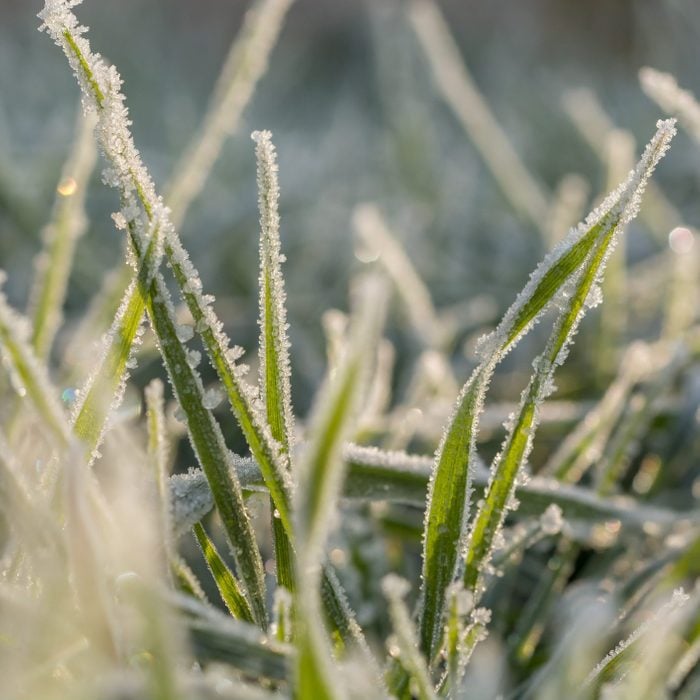
How to Treat Snow Mold
The good news is that snow mold usually takes care of itself because it dies as temperatures increase (gray mold dies at about 45 degrees F and pink mold at about 60 degrees F.) The other good news is that the effects of snow mold aren’t particularly extreme. If you want to get rid of it faster:
- Mow the lawn as usual because tall grass is a great breeding ground for mold
- Gently rake over any straw-colored circles to help dry out the area faster.
- Hold off on putting chemicals on the lawn because they aren’t necessary if the grass heals itself.
Read up on the lawn and gardening maintenance tips you should know.
How to Prevent Snow Mold
In some ways, this one is out of your hands because it depends on what you can’t control: the weather. However, there are some lawn fungicides that you can apply in late fall. Also, take pristine care of your lawn before the first snow falls by clearing all debris and keeping grass cut short. And, be sure to follow these additional tips for keeping your lawn healthy through winter.
Grow greener grass this season by following these helpful tips.
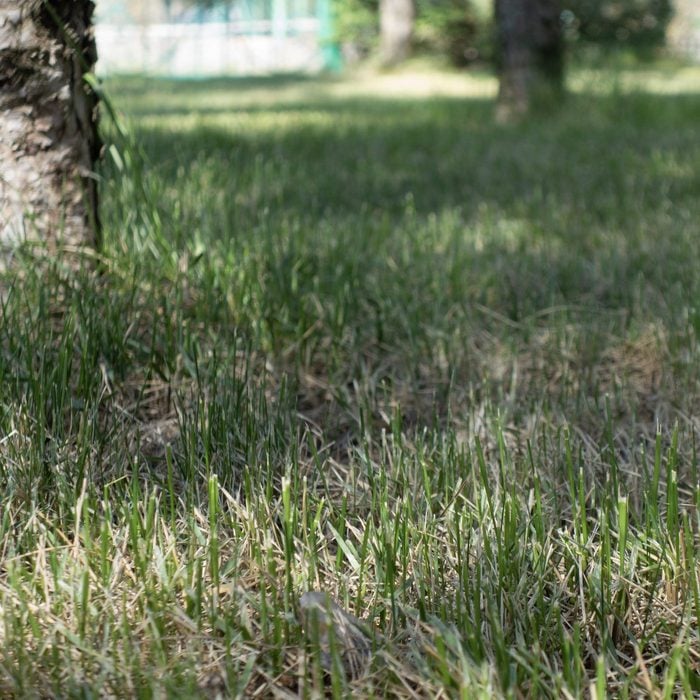
Why is My Lawn Thinning?
Lawn looking thin, bare or brown? You can revitalize it in a weekend using just one or two tools from a local rental or garden center. The power core aerator loosens any compacted soil in your yard and breaks up thatch. Thatch is a cushion of old, partially decayed grass roots and stems that develop in many sodded lawns. It separates the actively growing crown of the grass plant from the soil surface.
The power rake is equipped with vertical fixed tines to cut the soil and prepare a thinned-out lawn for reseeding.
For you northern homeowners whose lawns experience a hard freezing winter, the first dew in August is your signal that it’s time to aerate to ensure lush grass next spring. For homeowners in warmer or more arid states, aerate your lawn next spring to boost those warm-climate grass varieties before they go dormant in mid-summer.
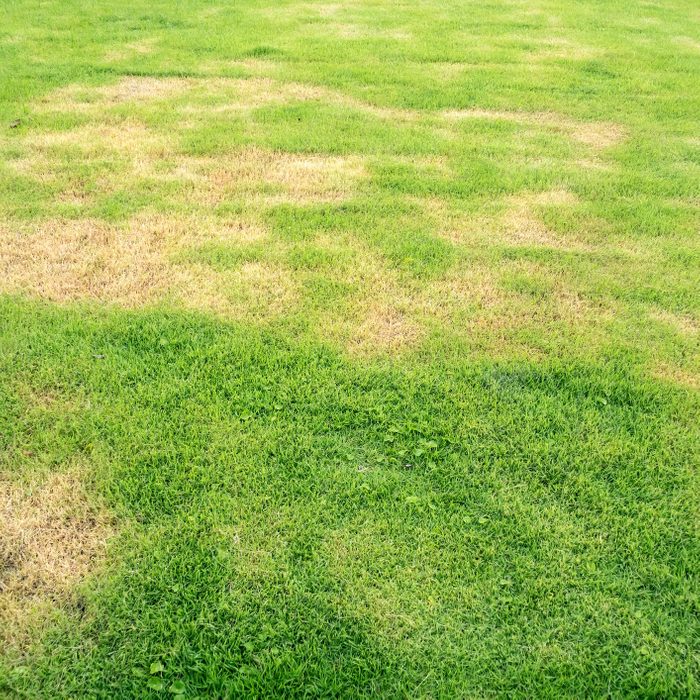
Why is My Lawn Patchy?
Is your lawn looking a little tired and bare? If so, don’t worry—fall is a great time to rejuvenate it. The weather is good for seed germination and competition from weeds is at its lowest. Here’s how to seed your lawn to thicken it. Start by loosening compacted soil to stimulate growth.
How to Fix a Patchy Lawn
Many patchy lawns suffer from compacted soil, which deprives grass roots of needed oxygen. Removing plugs of soil with a core aerator (rent at tool rental, garden supply or hardware stores) allows air and water to penetrate the ground and leaves space for surrounding soil to expand and loosen. Plan ahead and reserve the core aerator for at least half a day for an average-size lawn. It’s best to use the aerator when the soil is moist. You’ll need a truck or trailer to haul the core aerator home. The machine weighs 150 to 200 lbs., so it takes some muscle to move around. If you’re not up to the task, consider hiring a lawn service for this part of the job (it may not cost much more than renting the aerator). Allow a day between aerating and seeding to let the soil plugs dry. Dry plugs will break up easier when you blend them in along with the dressing of topsoil. Find out what type of seed you should pick up next.
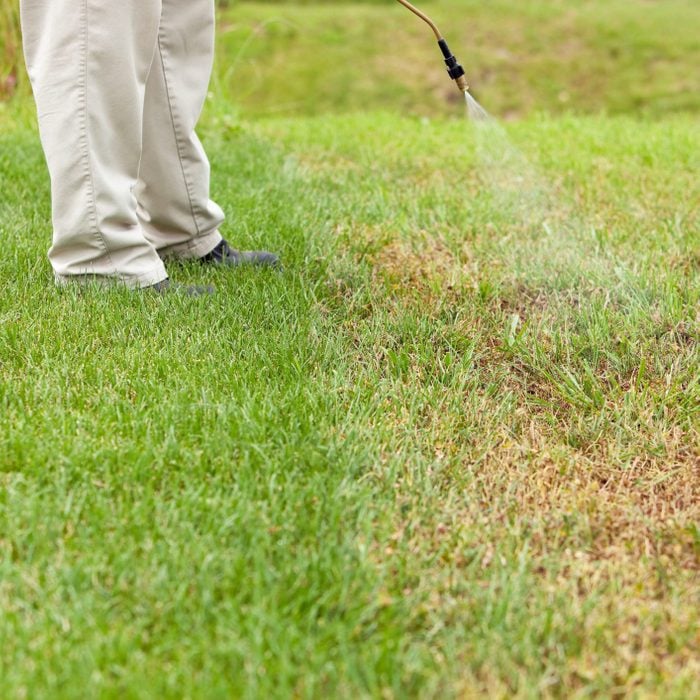
Crabgrass
The best weapon you have to know how to kill crabgrass is pre-emergence herbicide (also called crabgrass preventer). You apply this product in the spring before the crabgrass seed sprouts. This granular herbicide works by creating a chemical barrier at the surface of the soil. As the seeds begin germination, they take in the herbicide and die.
How to Apply Pre-Emergent Herbicide
The most cost-effective way to apply a pre-emergent herbicide is to use a fertilizer with crabgrass preventer added to it. These combination products are readily available in the spring and cost about $20 for a 5,000-sq.-ft. bag at garden centers. Apply crabgrass preventer when you would normally apply your first application of fertilizer, and do it just before it rains to work both the fertilizer and the herbicide into the soil. The fertilizer will help thicken the turf. Thicker turf helps to squeeze out crabgrass plants missed by the herbicide. Common brands include Ferti-Lome’s Weed-Out, Sta-Green’s Crab-Ex Plus and Scotts Turf Builder.
Check out the rest of our bag of tricks to get rid of crabgrass.
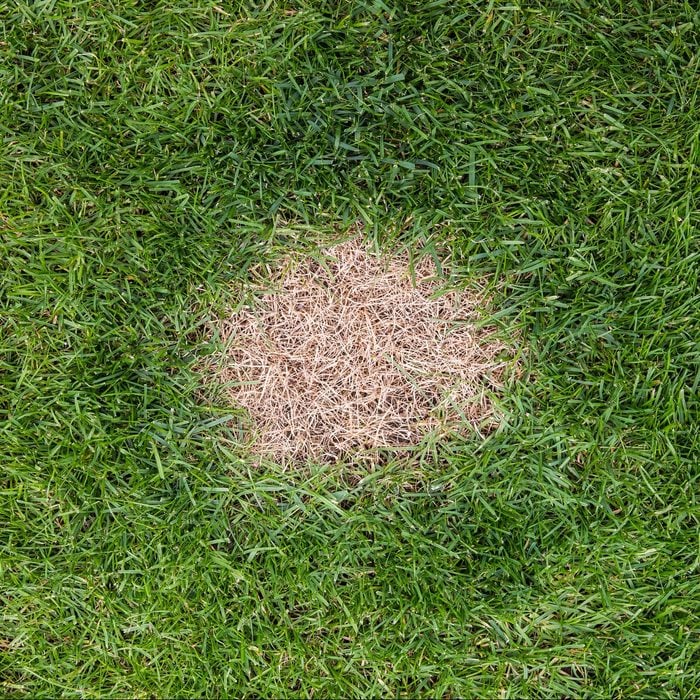
Dog Spots on Grass
Dog spots are round patches about 4 to 8 in. in diameter with dead grass in the middle, encircled by dark green grass. They’re most apparent in the early spring when dormant grass first begins to turn green again. Here’s why you should pick up dog poo before you mow, too!
Why do dog spots kill grass?: Dog urine contains high concentrations of acids, salts and nitrogen, which burn (dry out) the grass roots and kill them. As rain washes the area, the urine is diluted and the nitrogen spreads, causing the grass surrounding the spot to grow faster and turn greener.
How to Get Rid of Dog Spots: You have to replant your grass; it won’t come back on its own. But first you have to dilute or remove the caustic urine from the soil. Thoroughly soak the area with lots of water. Let the hose run for at least three minutes. Then you can start the replanting process. Add a half inch of new soil to help absorb any remaining urine. Then you can spread new seed, as we show, or use a commercial yard patch mixture (available at most nurseries or home centers) or even sod. In any case, the secret of good germination is keeping the seed moist. And keep the area moist until the new grass is about 3 in. high.
When you’re watering new seed, moisten the soil daily and keep it damp—but don’t soak it. Overwatering is a common mistake.
Recovery time: Four to six weeks.
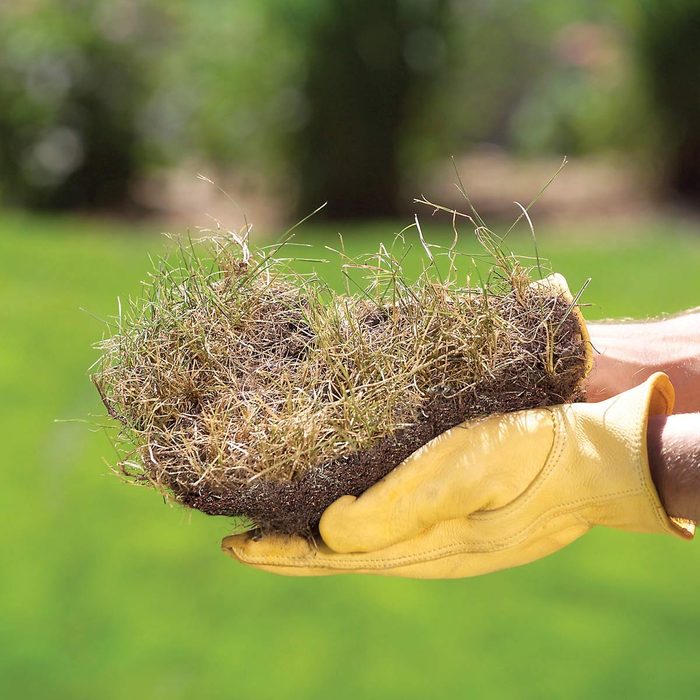
Thatch
Symptoms: If your grass feels soft and spongy when you walk on it, your lawn may have a thatch buildup. Thatch is a fibrous mat of dead stalks and roots that settles between the lawn’s green leaves and the soil. When this mat becomes greater than 3/4 in. thick, it can cause your lawn to suffer from heat and drought. Affected lawns will rapidly wilt and turn blue-green, indicating they’re hot and dry.
What causes thatch?: Cutting off too much at each mowing (letting the grass get too long) and cutting too low. Both will produce more dead grass tissue than microbes and earthworms can recycle. Thatch can develop in any soil but is most often associated with high clay content. Other causes are over-fertilization and frequent, light watering, which encourage a shallow root system.
How to Repair Lawn Thatch Buildup: Slice open a section of your lawn. If your grass shows 3/4 in. or more of thatch, it’s time to rent an aerator. An aerator is a heavy machine that opens the soil by pulling up finger-size soil cores. The lawn will absorb more oxygen and water, which will encourage healthy microbe growth and give worms wiggle room.
Aerate in the spring or fall when the grass is growing but the weather is not too hot to stress the plants. If the machine isn’t pulling plugs, your lawn may be too dry. To avoid this problem, water thoroughly the day before you aerate. You can also rake in topsoil to increase the healthy microorganisms that aid thatch’s natural decomposition. Topsoil is available at any garden center or online at Amazon.
Recovery time: You can expect the thatch layer to decrease by about 1/4 in. per year, about the same rate at which it forms.
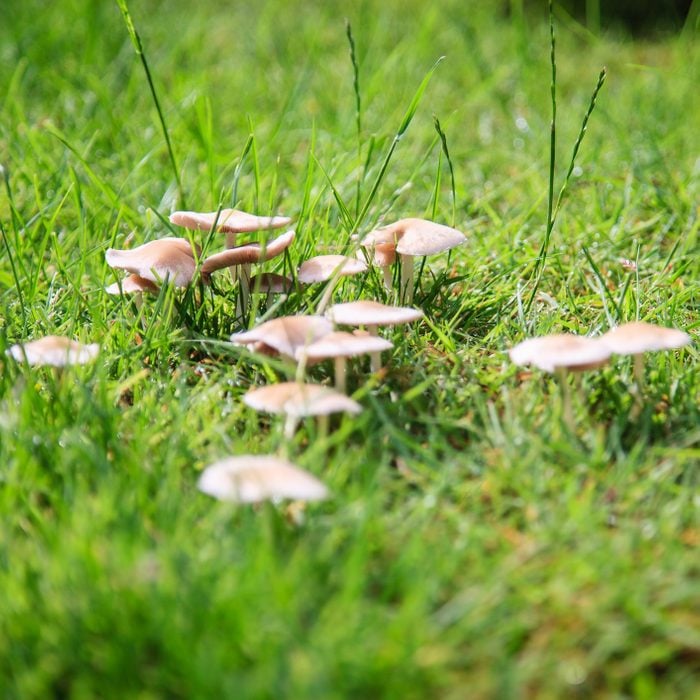
Why are there Fairy Rings in my Yard?
Symptoms: What are fairy rings? Fairy rings are circles approximately 3 to 8 ft. wide that consist of a dark green and fast-growing area of grass surrounding an inner area of partially dead or thin grass. Some rings also produce mushrooms.
What causes fairy rings?: Fairy rings are caused by fungi that live in the soil. As the fungi feed on organic matter, they release nitrogen, causing the grass to turn dark green. As the colony grows, it disturbs the flow of needed water to the turf roots, creating thin or dead spots. Fairy rings often begin with the decomposition of organic matter, such as an old tree stump buried under the lawn.
How to get rid of fairy rings: By bringing up the color in the rest of your lawn with a nitrogen fertilizer, you can mask much of the over-greening of the fairy ring. Hand-aerating the ring will break up the fungus and allow the flow of water and other nutrients to the grass roots.
Recovery time: Generally fairy rings can be masked with the application of fertilizer, with results in 10 to 14 days. The grass within the ring will thicken up with aeration in about two to three weeks. Try picking up a pair of aerator shoes and these incredible yard tools.
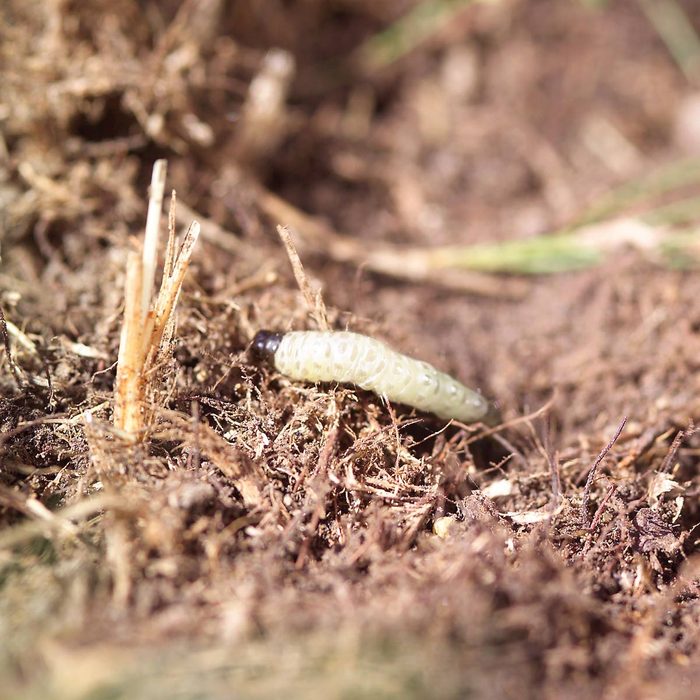
Why are There Grubs in my Yard?
Symptoms: Grub-chewed turf has patchy areas that wilt and die. You can easily pull up the affected turf if you tug on it. Another indicator of grubs may be increased raccoon, bird or mole activity. They like to dig up and eat the grubs at night. While this may sound good, the moles will kill the grass as they forage for grubs. Are moles making those holes in your yard? Learn how to repair mole holes in your lawn.
What causes grubs: Lawn grubs are the larval stage of moths and beetles. The grubs eat the roots of grass, setting them up for death by dehydration.
How to get rid of grubs: Be vigilant. Are beetles swarming around your porch light? In the next month, keep an eye out for patches of grass that wilt or are blue-green on hot days. They may be larvae infested. Turn over some turf. If you count six to 10 grubs (white wormlike larvae with black heads) under a 1-ft.-square area of sod, consider using a grub insecticide (available at home centers and nurseries, as well as online at Amazon). Or talk to a professional (search “Grass Service” online) about treating your yard. They will be familiar with the grub problems in your region and the most suitable treatment methods.
If you spot the grubs but your count is lower than six per square foot, baby your lawn to strengthen its natural defenses. Mow on higher blade settings and water thoroughly but infrequently to encourage the grass to grow new, deep roots. Do not cut off more than one-third of the grass height at each mowing, to avoid stressing the plant.
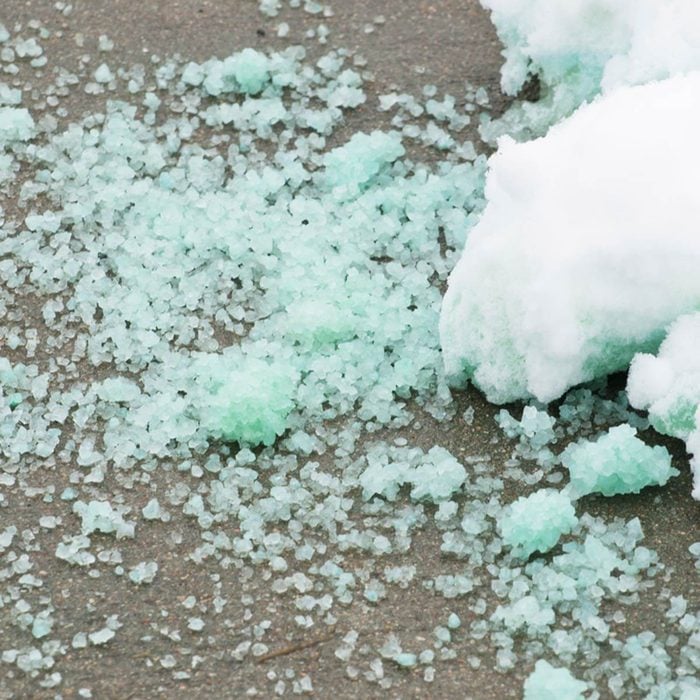
Why is There Dead Grass Near the Driveway and Sidewalk?
Get rid of leftover deicing salt
Also, if you live where winters are cold, grass near sidewalks and driveways may suffer damage from deicing salt. You can apply a thin layer of pelletized or granular gypsum—a naturally occurring mineral used as a soil conditioner—to replace the salt with calcium and sulfur. Water thoroughly. To minimize damage in the future, consider using sand or cat litter instead of salt.
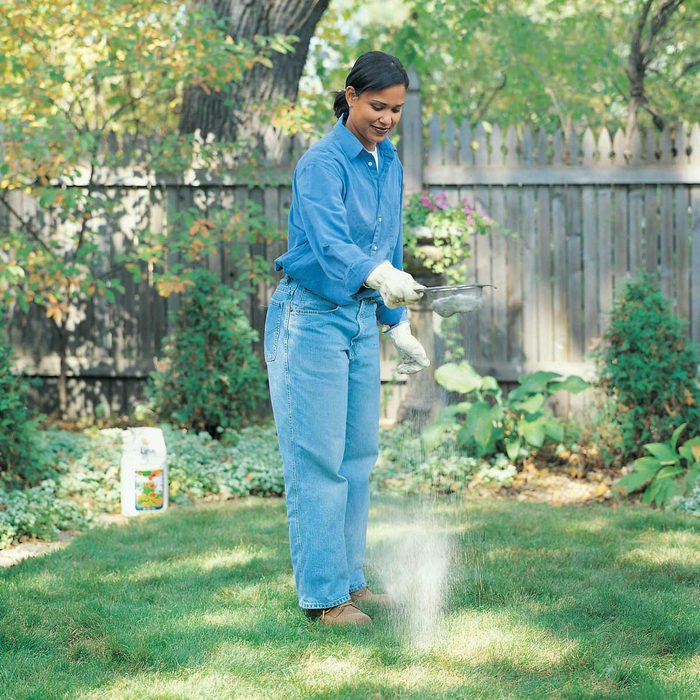
Why Isn’t My Lawn Healthy?
Soil pH (acidity level) is very important, and just because your dirt looks rich and black doesn’t mean it’s the right pH for grass. Take samples around the yard and get them tested. If the pH is too low (acidic) or too high (alkaline), the grass isn’t happy to be there. But you can fix the problem by adding lime to raise the pH or iron to lower it. Most grasses prefer a pH of 6.0 to 7.2.
Note: Lawn and garden centers sell do-it-yourself pH testers; more accurate tests can be performed by extension services.
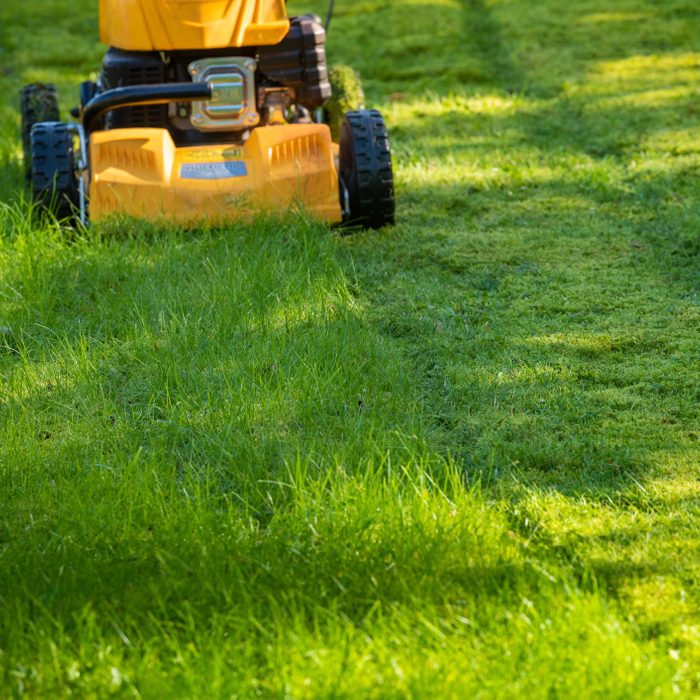
What Happens if You Don’t Mow for a While?
Mowing is a chore that’s easy to put off—the grass will still be there in a couple days. But delay is bad for your grass. The taller it gets, the more you’ll cut off when you finally mow. And the more you cut off, the more you’ll “shock” the grass. That weakens each individual plant and leads to other problems later on. It also opens up the turf canopy and allows weeds to bully their way in.
Rule of thumb: Never remove more than one-third of the leaf blade each time you mow. And keep your lawn mower blade sharp. A clean cut reduces the chance of common lawn diseases, such as grass rust, making their way into the leaf tissue. Your lawn will look much better too.
Find out the one thing you need to pick up before you start mowing.
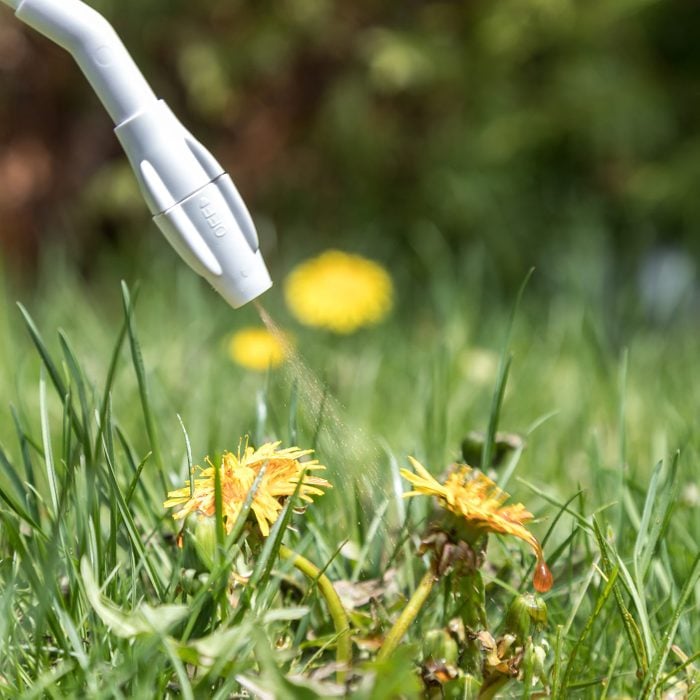
When to Attack Weeds
You need to kill weeds when they’re growing. That’s because the herbicide is absorbed through the leaves and then sent throughout the rest of the plant. When the weather is too cool, the weed isn’t growing and the herbicide won’t be absorbed, and the chemical isn’t as effective. Too hot and the herbicide will stress the grass. The product directions will give you the best temperature range. Apply herbicides when rain isn’t forecasted; a soaking will just rinse off the herbicide before it can do any good. Finally discover the ultimate guide to getting rid of weeds in the yard.


















